What’s involved in Project Intervene
Project Intervene helps owners corporations get their serious building defects resolved through a structured and efficient process.
What are the benefits of Project Intervene?
- We negotiate with the developer on your behalf to get a commitment to fix the agreed list of serious defects (known as a developer undertaking)
- An independent person is appointed to ensure the works are completed in compliance with legislation within an agreed time limit
- You can avoid having to take legal action. While legal action may provide a monetary solution, it still leaves responsibility for resolving the serious defects with the owners corporation.
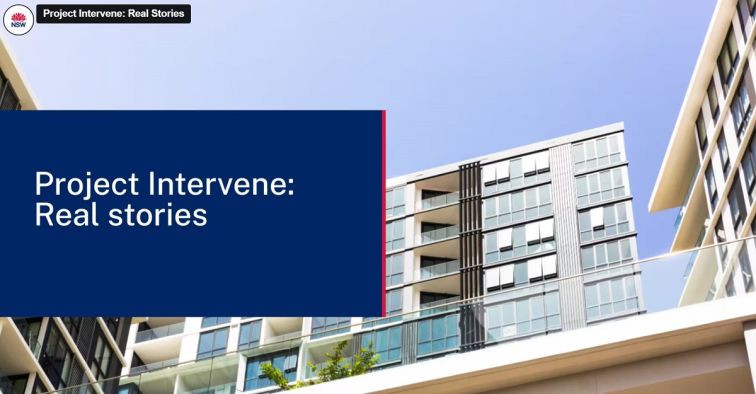
Real stories
Read transcriptIs your building eligible?
To be eligible for Project Intervene, your building must meet all the following criteria:
- The building must be a class 2 residential apartment building with three or more storeys (a storey of a building is from the ground up and does not include levels below ground);
- There must be a serious defect and it must relate to one of the five building elements in the common property;
- The developer or builder who did the building work must still be active or trading;
- The occupation certificate was issued in the last 10 years.
Project Intervene steps and timeline
The program timeline can be variable depending on several factors. All steps are necessary to achieve a successful remediation of defects in your building. Your dedicated Undertaking Manager will support you throughout the process.
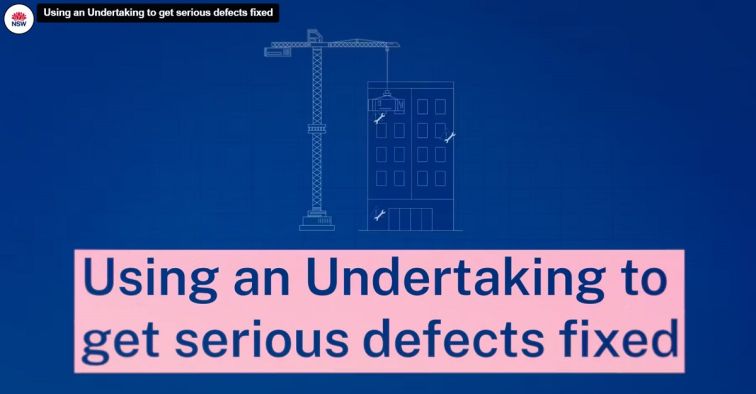
Using an Undertaking to fix a serious defect
Once we receive an application from an owners corporation's representative, a member of the Project Intervene team will review your application and may contact you for more information. This usually takes 20 business days.
If your building is eligible, we will collect available documentation and arrange for an independent inspection of your building to be carried out with the appropriate specialists.
The inspection is a dip test (that is, non-destructive), however it does aim to capture the significant serious defects. If further serious defects are discovered later, they can be added to the list, but it is expected that most issues are identified in these earlier stages. The inspectors will also review all material including any earlier reports provided.
The preliminary findings of the inspection will be shared with the developer for feedback. It is not shared with the owners corporation and cannot be used by the owners corporation even if the undertaking does not eventuate.
Timing: 6 weeks from the inspection to issuing preliminary findings.
Who: Building Commission NSW and building consultant(s). The strata committee or strata manager will need to allow access to the building.
a) We issue preliminary findings of an inspection
We share the preliminary findings of the inspection with the developer.
b) The developer may sign an Undertaking Process Deed Poll
Based on the preliminary findings, the developer may agree to enter a process where we negotiate an Undertaking. At this stage, the developer signs the first of two Deed Polls, the Undertaking Process Deed Poll.
c) The Undertaking Manager is appointed
The signing of an Undertaking Process Deed Poll triggers the appointment of an Undertaking Manager. Their role is to work with the developer to finalise the list of serious defects to be remediated and the expected timeline for remediation work.
Timing: 1-2 weeks to appoint the Undertaking Manager and 12-16 weeks to finalise the serious defects list (however this may take longer depending on nature of the defects and extent of investigations required).
d) The developer offers the Secretary of the Department of Customer Service an undertaking. The Secretary may delegate this to the NSW Building Commissioner.
Once the Undertaking Manager finalises the list of serious defects in consultation with the developer, and taking account of the owners corporation’s views, the developer provides an undertaking to Building Commission NSW.
The undertaking sets out:
- the process for rectification of serious defects (or monitoring of future defects, if any);
- requirement for regulated designs and declaration;
- the role of the Undertaking Manager, Superintendent and Owners Corporation;
- insurance, costs, and indemnity requirements;
- dispute resolution processes;
- pro forma deed polls from and in favour of the Owners Corporation.
A security deposit may be agreed upon as part of the undertaking.
Timing: 4 weeks to negotiate and agree the final undertaking.
Who: Building Commission NSW, developer, and (if appointed) the Undertaking Manager.
e) Final undertaking signed by the developer
Once the undertaking is final, the developer signs the Deed Poll and offers it to the Secretary of the Department of Customer Service.
If the terms are agreed, the Secretary will accept the undertaking. The undertaking is an agreement between the Secretary and the developer for the benefit of the owners corporation.
Timing: 2-3 weeks.
Who: The developer and Building Commission NSW.
f) Owners corporation agrees to the undertaking
To get the benefit of the undertaking, the owners corporation must agree to it by vote at a general meeting and sign the Owners Corporation Deed Poll.
Timing: 6 weeks.
Once it is agreed, the owners corporation signs the Owners Corporation Deed Poll. A copy of this Deed Poll is provided to the developer so each party has a complete set of documents.
If an undertaking cannot be achieved we may issue a Building Work Rectification Order
If an undertaking cannot be achieved (for example the developer or owners corporation cannot agree to a list of serious defects or terms of the undertaking cannot be agreed), we may issue a final building work rectification order.
The building work rectification order is internally approved before issuing it to the developer, and the owners corporation. Building Commission NSW may publish the undertaking online in full, in part, or not at all at our discretion.
Timing: 10 weeks to issue and developer to provide submissions (however this can be extended further by request by the developer).
Who: Building Commission NSW, developer, Undertaking Manager, strata committee and the owners corporation (vote required).
Before any building work can start, the developer (or builder) must ensure there are regulated designs for the remediation work (where necessary). The designs must be declared by a registered design practitioner.
A registered building practitioner must enter the declared regulated designs into the NSW Planning Portal.
The building practitioner must carry out works in accordance with the declared designs.
Timing: Varies and depends on the complexity of the work and the availability of registered design practitioners.
Who: The developer, registered design practitioner and registered building practitioner.
A Superintendent is jointly appointed by the developer and Building Commission NSW to oversee that the building work is completed in a compliant manner. They are independent of the developer. The developer covers the cost of the appointment of a Superintendent.
You should continue to liaise with the Undertaking Manager or Superintendent if you have any questions about the program and delivery of remedial works.
Who: The developer, Building Commission NSW and Superintendent.
As soon as the designs are declared and uploaded on the NSW Planning Portal by the building practitioner, the works can commence. The owners corporation will need to provide access to the building to ensure timely completion of remedial building works.
The work can be undertaken by the original builder and by the original tradespeople involved, however it does not have to be.
Timing: Up to 12 months (sometimes longer) – the time varies considerably according to what remediation work is required and the availability of design practitioners, a building practitioner, and related tradespeople. In some cases, the time may be extended if, in the opinion of the Undertaking Manager, a time extension is warranted.
Who: The developer, builder, contractors, Undertaking Manager and Superintendent
At the end of building work, the building practitioner will be required to declare the works are completed in accordance with the designs and entered into the NSW Planning Portal.
The Superintendent will sign-off to confirm the works are completed and meets all relevant standards. The Undertaking Manager will review and provide sign-off of the completion of works.
If a bank guarantee has been offered it will remain in place until the expiry period. If no claim is made it will expire.
Who: The developer, Superintendent, Building Commission NSW and owners corporation.
Definitions of key terms
Serious defect
A serious defect has a specific definition in the Residential Apartment Building (Compliance and Enforcement Powers) Act 2020 legislation, namely that it:
- arises from a failure to comply with the performance requirements of the Building Code of Australia, Australian Standards or approved plans;
- is likely to cause the inability to inhabit or use, the destruction of or threat of collapse of part of the building due to defective design, faulty workmanship or materials;
- involves the use of a building product that is prohibited by the Building Products (Safety) Act 2017 (NSW);
- includes any defects which are prescribed by the Regulations (if any):
- related to a building element.
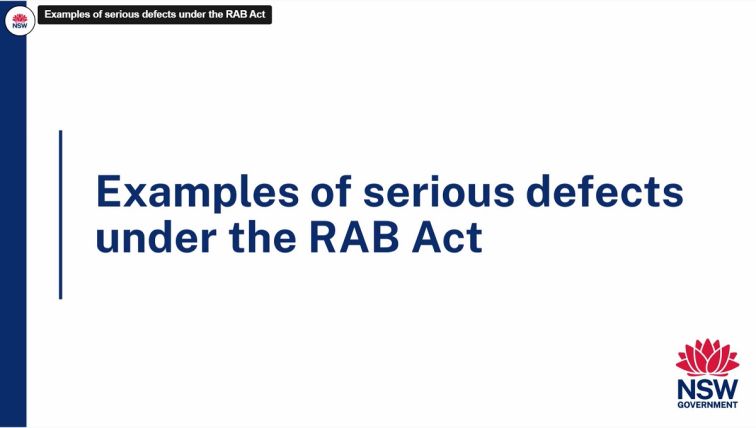
Examples of serious defects under RAB
Common property
The common property, as defined in the Strata Schemes Development Act 2015, is any part of the building that is not comprised in a lot (but might be inside a lot), including any common infrastructure.
An example of common property that might be “not comprised in a lot (but might be inside a lot)” might be electrical wiring or plumbing that is for the building or other apartments (common property) but which passes through an individual apartment.
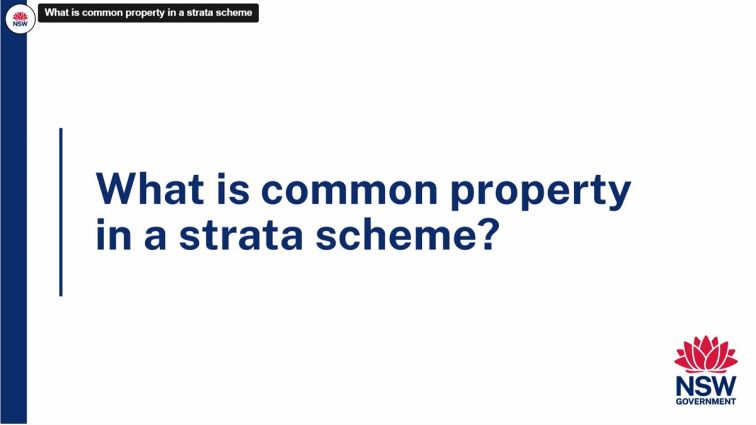
What is common property in a strata scheme
Building element
To be included in Project Intervene, a serious defect must be related to one of the five building elements which are identified under the Design and Building Practitioners Act 2020. Some examples of serious defects related to each building element are included below.
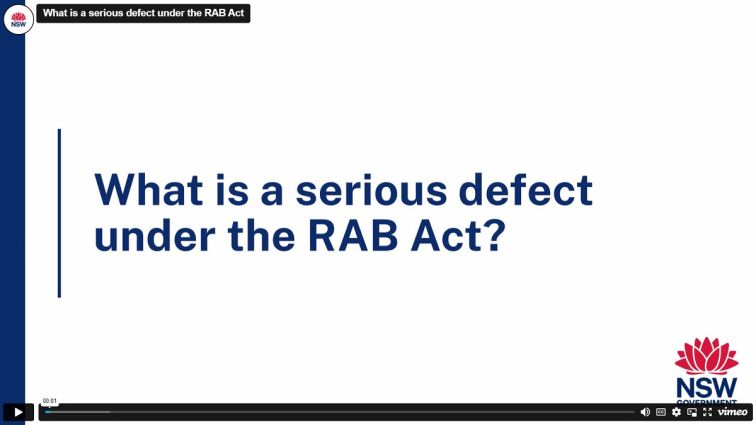
What is a serious defect under RAB
Some examples of serious defects in the fire safety building element may include:
- Fire penetration
- Fire pump room
- Fire stairs
- Fire doors
- Substation
Some examples of serious defects in the waterproofing building element may include:
- Planter box
- Bathroom
- Balcony
- Roof
Some examples of serious defects in the building structure building element may include:
- Cracking in slab
- Expansion joints
- Ensuring built according to the designs (for example, columns, walls)
- Honeycombing
Some examples of serious defects in the building enclosure may include:
- Cladding / enclosure
- Moisture management
- Suitable material
Some examples of serious defects in the building services may include:
- Mechanical ventilation
- Electrical
- Plumbing / drainage
- Hydraulic
- Lifts
- Services cupboard
Waterproofing and common property
Waterproofing in an individual apartment such as the bathroom, the kitchen, the laundry, or the balcony is common property (provided there has been no renovation).
Once there has been a renovation of any wet area in an individual apartment, then it is no longer common property and it is the responsibility of the individual apartment owner.
Definitions of key roles
Developer
A developer is defined in section 4 of the RAB Act and section 4 of the Strata Schemes Management Act 2016. Learn more on Fair Trading about a developer’s obligations when working on a regulated building.
Project Intervene uses the powers under the RAB Act. Under the RAB Act, a developer can offer the Secretary of the Department (of Customer Service) an undertaking to remediate serious defects (see section 28).
Undertaking Manager
The Undertaking Manager’s role is to oversee the performance of the undertaking which includes:
- finalising the list of serious defects in consultation with owners corporation and developer,
- ensuring the remediation work is delivered on schedule and meets the relevant standards, and
- resolving disputes.
The Undertaking Manager has experience in the building and construction industry as well as experience and skills in negotiation and dispute resolution.
They are selected from a panel of Undertaking Managers held with Building Commission NSW. They are jointly appointed by Building Commission NSW and the developer, but the developer pays for their cost. The Undertaking Manager role is always independent from the developer. The Undertaking Manager helps resolve any issues or disagreement. The Undertaking Manager's decision is final.
Superintendent
The Superintendent oversees work on site and liaises with the developer, Undertaking Manager, owners corporation, tradespeople and contractors. They must always act independent of the developer.
Common questions
Project Intervene was established as a full program in November 2022. Our approach of using an undertaking to get serious defects fixed is new one.
However, the early indications seem to be that insurers, when properly briefed, can be satisfied when a developer has signed an undertaking because there is a clearly defined process for getting the serious defects fixed in a compliant manner and in a clear timeframe.
You should seek your own advice. Check with your building insurer and consider a quote from alternative insurers.
Project Intervene uses the powers under the RAB Act which allow us to pursue the developer and builder to fix the serious defects. This means the developer (or the builder) must still be in business. Where the developer and builder are de-registered or wound up, Project Intervene may not be able to assist in getting an outcome.
While it is a challenging situation for us to pursue a developer once they have de-registered, and we may not be successful, we will approach the parent company to get the serious defects in your building fixed. We can also refer any individuals or director to the relevant authorities. We may also consider a review of any licences they hold in New South Wales.
You should register your building through the process outlined above. If your building is eligible for Project Intervene we will contact you.
Project Intervene uses the powers of the RAB Act to conduct inspections, issue directions or orders or accept an undertaking. These actions can occur in parallel to any legal proceedings.
We can take action regardless of whether the owners corporation has commenced legal proceedings about the serious defects against the developer or builder. However, once the undertaking is signed by the developer, the owners corporation must choose its pathway to get defects fixed – litigation or Project Intervene. It is likely both pathways will relate to the same set of serious defects.
Project Intervene is using compliance powers to have the serious defects fixed, which is ultimately for the benefit of the owners corporation. This process requires the owners corporation to pass a motion to give access for the remediation work to be done and accept other aspects of the process which are designed to have the serious defects fixed properly.
Unlike legal proceedings, the undertaking does not involve payment of damages to the owners corporation. It does, however, include a time frame by which the serious defects are to be fixed. The undertaking does not require legal or expert fees to be paid by the owners corporation.
Related information
- Research on serious building defects in NSW strata communities
- Undertakings in building and construction
- Register of building work orders
- Residential Apartment Buildings (Compliance and Enforcement Powers) Act 2020
- Residential Apartment Buildings (Compliance and Enforcement Powers) Regulation 2020
- Design practitioner obligations
- Work that is emergency remedial building work
- Building Products (Safety) Act 2017 (NSW)
